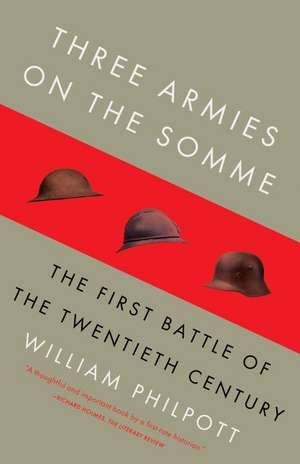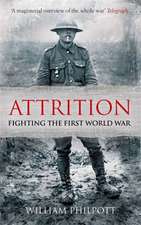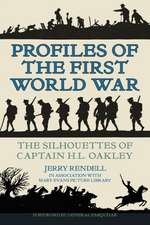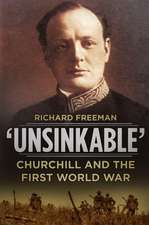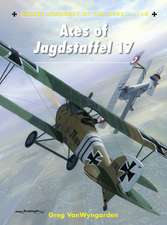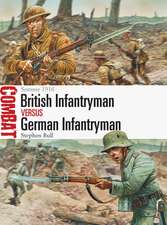Three Armies on the Somme: The First Battle of the Twentieth Century
Autor William Philpotten Limba Engleză Paperback – 31 oct 2011
Preț: 192.45 lei
Nou
Puncte Express: 289
Preț estimativ în valută:
36.83€ • 38.31$ • 30.41£
36.83€ • 38.31$ • 30.41£
Carte disponibilă
Livrare economică 24 martie-07 aprilie
Preluare comenzi: 021 569.72.76
Specificații
ISBN-13: 9780307278371
ISBN-10: 0307278379
Pagini: 631
Ilustrații: 24 PP. B&W; 9 MAPS
Dimensiuni: 135 x 202 x 34 mm
Greutate: 0.63 kg
Editura: VINTAGE BOOKS
ISBN-10: 0307278379
Pagini: 631
Ilustrații: 24 PP. B&W; 9 MAPS
Dimensiuni: 135 x 202 x 34 mm
Greutate: 0.63 kg
Editura: VINTAGE BOOKS
Notă biografică
William Philpott is Professor of the History of Warfare in the Department of War Studies at King’s College, London. He is a specialist in the operations on the Western Front and has published extensively on the subject. He lives in London.
Extras
On 1 July 1916, at precisely 07:28, a series of huge explosions tore open the ground around the small French hamlet of La Boisselle. A company of the 10th Battalion the Lincolnshire Regiment (the "Grimsby Chums") dashed from the British front line, outpacing men from the German110 Reserveinfanterieregiment (RIR) to seize the newly blown Lochnagar minecrater. All along the front the deadly race was repeated, as thousands ofBritish and French infantry rose in a long surging line, and Germanmachine-gunners hastened to their weapons. The winners might live to see adifferent world.
"The Last Post" is sounded at Lochnagar Craterevery 1 July, although nowadays there are no longer veterans among themourners. Nevertheless they will not fade away. Dutifully each year theirchildren, and after them their grandchildren and great-grandchildren, willgather at that sacred shell-hole to honour the memory of those who fought-andthose who died-in Britain's greatest battle. Elsewhere small parties of Frenchand Germans, Australians, Canadians and South Africans pay their respects, asthe Battles of the Somme pass from experience, through memory, into history.
THE RIVER SOMME, which meanders across north-west France,bisecting the rolling uplands of Picardy, has lent its name to four battles.The first encounter was in September and October 1914. The second and greatest-theBattle of the Somme-lasted for four and a half months, from June to November1916. The third took place in March 1918; the fourth in August 1918. Eventoday, the mention of this quiet river evokes deep atavistic sentiments: pride,anger, anguish, grief. The 1916 battle scarred the British national psyche inparticular: up to that point Britain had had no Verdun, the "Meusemill" which ground up the French army in early 1916, or Langemarck, theGerman army's Kindermord sacrifice of her eager young volunteers in autumn1914. Yet the reasons for that scar, and the true nature of the historicalphenomenon which inflicted it, are little understood. The 1916 Somme campaignwas a struggle of three armies, and three empires. Each left its young men andtheir memorials in that patch of Picardy downland, now lush, quiet andmournful. On the hills opposite Albert, the British army made its longest and greatestsacrifice in the allied cause. Astride the river to the south their Frenchallies were fighting their own gruelling battle, closely integrated withBritish operations but all but forgotten by posterity. To the east the Germanarmy fought its prolonged defensive Battle of the Somme, more bloody and morale-sappingthan the Anglo-French offensive, yet rarely acknowledged or recounted.
In the summer of 1916 Walter Page, the Americanambassador in London, noted that "war has come to be the normal state of life." The world had paused as three great empires, championed by theirarmies, staked their futures in a single great battle. The scale of the Sommewas immense, a global event impacting on the lives of everyone in WesternEurope and resonating beyond European shores. Millions of Frenchmen, Germansand Britons, and many thousands of colonial volunteers and conscripts-Australians,New Zealanders, Canadians, South Africans, Moroccans, Algerians and West Africans-convergedon that corner of a foreign field from twenty-five nations, all five continents. It was no small corner: from north to south the battlefield stretches some forty miles, from east to west twenty: as large as London southof the Thames. Most went willingly, believing in the cause: the liberation ofthe invaded patrie; the defence or aggrandisement of a besieged empire; thecrushing of rampant militarism; the forging of a national identity. Above all, honour and duty-loyalty to one's country, to one's army, to one's comrades-motivatedthe combatants. Three imperial superpowers found themselves enmeshed in a newkind of struggle, to the death: "a total war for the preservation of thenation" as General Ludendorff was to call it. The centrepiece of thisindustrial war was an industrial battle in which population, economy, industryand imagination all strained to sustain a battle longer and more intense thanany fought before. Back at home, anxious families waited for news; a letterfrom a son, brother, husband or father, or the much-feared official telegram.Munitions workers toiled to feed the guns and farmers harvested to feed themen. Journalists reported, writers commented, poets rhymed and artists painted.Having committed their armies and nations to the field, political leaders ofthe three struggling empires were rapt, their credibility and authority ontrial. Their rivals, of left and right, sought advantage from each turn ofevents. Allies watched their brothers-in-arms with interest and anxiety, theirown nation's cause inextricably tied up with that being disputed in Picardy. Neutrals monitored world-changing events, judging and rejudging their positionin the global struggle. Would the Battle of the Somme end the war? If so, whatwould be the peace? What if the war continued? Armageddon and Judgement Dayseemed one.
As the summer drew on casualty lists lengthened; all, it appeared, for a few square miles of insignificant French countryside. Thecombatants knew that much more was at stake than mere ground and human life:honour; reputation; culture; tradition; the future. It must be victory, orextinction. Fighting for one meant change for all, as on the Somme the oldfamiliar world perished and a new uncertain world emerged. As German veteranErnst Jünger attested: "Chivalry here took a final farewell...The Europeof today appeared here for the first time on the field of battle."
It is this 1916 battle which has left its mark on ourcollective psyche, but the Somme experience reaches much further. As well asthe several million men who actually fought on the Somme-not just in 1916, butin 1914, 1915, 1917, and 1918-millions more then and later lived theirexperience vicariously, through newspapers and films, poetry and paintings,memoirs, plays, novels and histories. Many thousands took their experience withthem to the neatly tended graves or unmarked plots they occupy to this day.Others survived yet left no record. Many, however, lived to tell their tales;soldiers' tales. In the war-of-words which follows any battle, officialdespatches from the commanders-in-chief sought to explain and justify theiractions. Diaries, memoirs and letters of those who had fought proliferated. Afew became celebrated classics: most are long-forgotten.
One memoir in particular constructed the Somme of popularmemory. Winston Churchill, who lived by the pen as well as the sword, found theformer an effective weapon in the so-called battle of the memoirs whichfollowed the war. Although Churchill's career subsequently prospered, whenwriting The World Crisis, his memoir-history of the First World War, the formerFirst Lord of the Admiralty was defending his own far from unblemished warrecord. He shared responsibility for the ill-planned and badly executed Dardanelles campaign, which forced his resignation from the Cabinet in November1915, after which he spent eighteen months out of office, in the trenches andon the backbenches. In 1916 he had been restless and critical, observing a warwhich apparently was not being won and looking for reasons and scapegoats, and his egocentric memoir revisited these wartime gripes. He had the uniqueperspective of someone who had both served at the front and moved in thehighest political circles. Yet, like many of his contemporaries, he was toocaught up in events to appreciate the bigger picture; too preoccupied with hisown part in affairs to consider the roles of others. As he wrote to his wifewhile he worked on the first volume of his history: "It is a great chanceto put my case in an agreeable form to an attentive audience."
Published in 1927, Churchill's account of the Battle ofthe Somme in The World Crisis was to manufacture one of Britain's great historical myths. Ironically, the man whose account of the Somme has provedmost influential had little to do with it. Churchill enjoyed the luxury ofdissociation: he was not at the front and he had no ministerial responsibility.A troublemaking and under-employed backbench MP in 1916, he watched and judged.His critique of the genesis and conduct of the battle is founded on his ownstrongly expressed opinion, at the end of the battle's first month, that theBritish army's casualties were significantly higher than the enemy's. Then hisobjection was ignored: the offensive was just getting into its stride. YetChurchill remained too involved ever to rethink or revise this highly specificcontemporary critique, which in The World Crisis is subsumed into a generalnarrative of what were to become familiar clichés, the product of a self-absorbedrefusal to investigate the bigger picture: unimaginative and callous generals; ill-plannedand futile offensive operations; high and unnecessary casualties; atrociousbattlefield conditions; technophobic cavalrymen failing to appreciate the potentialof new war-winning weapons, notably the tank. Churchill thus set the agenda forsubsequent generations' perception of the Battle of the Somme, and the war ofwhich it was the defining and pivotal event.
Written in Churchill's lucid and compelling prose, theyproved popular accusations. The first printing of volume one of The World Crisis instantly sold ten thousand copies; the whole six-volume series (the third volume of which covered the Somme) sold more than a million copies intotal. Serialisation in The Times disseminated Churchill's message among thegeneral public, and syndication in Europe and the empire reached the widerworld. Cheaper, abridged, popular editions of The World Crisis, first published in the 1930s, reprinted in the 1960s on the fiftieth anniversary of the war,and most recently in 2007, kept Churchill's impression current. Here was asoldier, statesman and wordsmith who apparently could make sense of a conflictwhich defied understanding: who could explain the reasons why so many had died,and seemed to know who should be held responsible. Yet even on publicationChurchill's words provoked concern, and they have stood up poorly to subsequentscholarly analysis. "The very attractiveness of Mr. Churchill's writing ofitself constitutes a danger; for the layman may well be led to accept facilephrase and seductive argument for hard fact and sober reasoning," Lord Sydenham commented in introducing a collection of early criticisms of The World Crisis, and in a later scholarly critique Robin Prior concluded thatChurchill's best-selling account of the war was "to shape the popularhistorical memory of the recent past in its own image." Indeed, Churchill's widely read nostrums and cavils have become the familiar staples ofFirst World War literature, recycled again and again to a credulous public.Perhaps they reach their apogee in the influential work of A. J. P. Taylor, thepacifist historian whose scathing narrative of the war has dominated popularconsciousness for over forty years.
Churchill did not understand the First World War, or thecentral place of the Somme within it. As Gary Sheffield recently commented,Churchill's analysis of the Somme "combines a blithe disregard for whatwas possible in 1916 with an astonishing lack of understanding of the realitiesof combat on the Western Front." Churchill showed no appreciation of themilitary skill, strength of purpose and moral courage required to fight and winsuch a battle and such a war: a battle and war of attrition. Although he couldexplain his own role and attitude well enough, as Sydenham recognised, "inaccordance with the views he consistently holds," he was unable to admitthat the Somme, a key element of a coherent whole, in fact came close tosuccess. More apposite was Lord Esher's post-war verdict, that "the battleof the Somme settled the inevitable issue of the War." The British Empirecommitted its keen volunteer citizen armies to this three-nation encounter. France contributed the military expertise of her much-battered army. The Germanarmy offered resistance almost to the end of its resources and moral strength.Three empires engaged with and suffered through this blood-sacrifice, and itslong, tragic denouement. It is wrong and morally reprehensible to dismiss thishuman phenomenon on the grandest scale as a futile engagement in a futileconflict, as so many do.
TO APPRECIATE THE true nature of the Somme the battlemust be viewed through the eyes of those who fought and observed. Even beforethe guns had fallen silent Britain's official battle chronicler and future poetlaureate John Masefield had begun work on The Old Front Line, the first of manyguides to the battlefield "from which the driving back of the enemybegan." As he surveyed the British front of 1 July 1916 he felt that thewar and the world were turning:
The old front line was the base from which the battleproceeded. It was the starting-place. The thing began there. It was the biggestbattle in which our people were ever engaged, and so far it has led to biggerresults than any battle of this war since the battle of the Marne. It caused agreat falling back of the enemy armies. It freed a great tract of France,seventy miles long, from ten to twenty-five miles broad. It first gave theenemy the knowledge that he was beaten.
Some sixty years later, as children and grandchildrenrediscovered their forefathers' fire-trench or resting-place along the oldfront line, Colonel Howard Green made clear, in the introduction to the 1972 reprintof Masefield's work, how the world had indeed turned: "For the men whofought there, and the nations they fought for, it was never the same after theSomme. The songs, the writing, the poetry, became cynical, after the Somme." Such war-induced cynicism has masked the true character of theSomme ever since.
As time moved on and events receded the weight of historyaccumulated. Historians assessed and judged these writings and recollections.Generals' reputations were made, lost and made again, and ordinary soldiers'stoic heroism gleamed ever more brightly from the greying mud. Military histories-official, scholarly, popular or sensational-sought to recount and critique the battle.One former subaltern in particular, Basil Liddell Hart, made his judgement onhistory and imposed his opinion on posterity. The most influential Britishmilitary writer of the inter-war years had fought on the Somme before gas hadcut short his front-line service. While recuperating he drafted a eulogy forthe high command. Later, invalided out of the army and disillusioned with itssuperior officers, he turned his productive pen to a critique of the army'sfailings in the Great War, and of Britain's continental strategy in general, asa salutary example for the future. In particular, his history, The Real War, laid out many of the charges for the trial-by-literature of the British commander-in-chief,Sir Douglas Haig, and his subordinates, which continues to this day. In thistone, Liddell Hart set the agenda for subsequent scholarship. As well as suchhistorical assessments, the Battle of the Somme left a rich artistic legacy. Serving poets, official war artists, demobbed novelists, unborn writers wove aliterary and cultural memory that obscured as much as illuminated the battleand the war of which it was a part. Gradually, inexorably,the battle passed from personal memory to popular myth, both a paradigm and acliché of the Great War.
From the Hardcover edition.
"The Last Post" is sounded at Lochnagar Craterevery 1 July, although nowadays there are no longer veterans among themourners. Nevertheless they will not fade away. Dutifully each year theirchildren, and after them their grandchildren and great-grandchildren, willgather at that sacred shell-hole to honour the memory of those who fought-andthose who died-in Britain's greatest battle. Elsewhere small parties of Frenchand Germans, Australians, Canadians and South Africans pay their respects, asthe Battles of the Somme pass from experience, through memory, into history.
THE RIVER SOMME, which meanders across north-west France,bisecting the rolling uplands of Picardy, has lent its name to four battles.The first encounter was in September and October 1914. The second and greatest-theBattle of the Somme-lasted for four and a half months, from June to November1916. The third took place in March 1918; the fourth in August 1918. Eventoday, the mention of this quiet river evokes deep atavistic sentiments: pride,anger, anguish, grief. The 1916 battle scarred the British national psyche inparticular: up to that point Britain had had no Verdun, the "Meusemill" which ground up the French army in early 1916, or Langemarck, theGerman army's Kindermord sacrifice of her eager young volunteers in autumn1914. Yet the reasons for that scar, and the true nature of the historicalphenomenon which inflicted it, are little understood. The 1916 Somme campaignwas a struggle of three armies, and three empires. Each left its young men andtheir memorials in that patch of Picardy downland, now lush, quiet andmournful. On the hills opposite Albert, the British army made its longest and greatestsacrifice in the allied cause. Astride the river to the south their Frenchallies were fighting their own gruelling battle, closely integrated withBritish operations but all but forgotten by posterity. To the east the Germanarmy fought its prolonged defensive Battle of the Somme, more bloody and morale-sappingthan the Anglo-French offensive, yet rarely acknowledged or recounted.
In the summer of 1916 Walter Page, the Americanambassador in London, noted that "war has come to be the normal state of life." The world had paused as three great empires, championed by theirarmies, staked their futures in a single great battle. The scale of the Sommewas immense, a global event impacting on the lives of everyone in WesternEurope and resonating beyond European shores. Millions of Frenchmen, Germansand Britons, and many thousands of colonial volunteers and conscripts-Australians,New Zealanders, Canadians, South Africans, Moroccans, Algerians and West Africans-convergedon that corner of a foreign field from twenty-five nations, all five continents. It was no small corner: from north to south the battlefield stretches some forty miles, from east to west twenty: as large as London southof the Thames. Most went willingly, believing in the cause: the liberation ofthe invaded patrie; the defence or aggrandisement of a besieged empire; thecrushing of rampant militarism; the forging of a national identity. Above all, honour and duty-loyalty to one's country, to one's army, to one's comrades-motivatedthe combatants. Three imperial superpowers found themselves enmeshed in a newkind of struggle, to the death: "a total war for the preservation of thenation" as General Ludendorff was to call it. The centrepiece of thisindustrial war was an industrial battle in which population, economy, industryand imagination all strained to sustain a battle longer and more intense thanany fought before. Back at home, anxious families waited for news; a letterfrom a son, brother, husband or father, or the much-feared official telegram.Munitions workers toiled to feed the guns and farmers harvested to feed themen. Journalists reported, writers commented, poets rhymed and artists painted.Having committed their armies and nations to the field, political leaders ofthe three struggling empires were rapt, their credibility and authority ontrial. Their rivals, of left and right, sought advantage from each turn ofevents. Allies watched their brothers-in-arms with interest and anxiety, theirown nation's cause inextricably tied up with that being disputed in Picardy. Neutrals monitored world-changing events, judging and rejudging their positionin the global struggle. Would the Battle of the Somme end the war? If so, whatwould be the peace? What if the war continued? Armageddon and Judgement Dayseemed one.
As the summer drew on casualty lists lengthened; all, it appeared, for a few square miles of insignificant French countryside. Thecombatants knew that much more was at stake than mere ground and human life:honour; reputation; culture; tradition; the future. It must be victory, orextinction. Fighting for one meant change for all, as on the Somme the oldfamiliar world perished and a new uncertain world emerged. As German veteranErnst Jünger attested: "Chivalry here took a final farewell...The Europeof today appeared here for the first time on the field of battle."
It is this 1916 battle which has left its mark on ourcollective psyche, but the Somme experience reaches much further. As well asthe several million men who actually fought on the Somme-not just in 1916, butin 1914, 1915, 1917, and 1918-millions more then and later lived theirexperience vicariously, through newspapers and films, poetry and paintings,memoirs, plays, novels and histories. Many thousands took their experience withthem to the neatly tended graves or unmarked plots they occupy to this day.Others survived yet left no record. Many, however, lived to tell their tales;soldiers' tales. In the war-of-words which follows any battle, officialdespatches from the commanders-in-chief sought to explain and justify theiractions. Diaries, memoirs and letters of those who had fought proliferated. Afew became celebrated classics: most are long-forgotten.
One memoir in particular constructed the Somme of popularmemory. Winston Churchill, who lived by the pen as well as the sword, found theformer an effective weapon in the so-called battle of the memoirs whichfollowed the war. Although Churchill's career subsequently prospered, whenwriting The World Crisis, his memoir-history of the First World War, the formerFirst Lord of the Admiralty was defending his own far from unblemished warrecord. He shared responsibility for the ill-planned and badly executed Dardanelles campaign, which forced his resignation from the Cabinet in November1915, after which he spent eighteen months out of office, in the trenches andon the backbenches. In 1916 he had been restless and critical, observing a warwhich apparently was not being won and looking for reasons and scapegoats, and his egocentric memoir revisited these wartime gripes. He had the uniqueperspective of someone who had both served at the front and moved in thehighest political circles. Yet, like many of his contemporaries, he was toocaught up in events to appreciate the bigger picture; too preoccupied with hisown part in affairs to consider the roles of others. As he wrote to his wifewhile he worked on the first volume of his history: "It is a great chanceto put my case in an agreeable form to an attentive audience."
Published in 1927, Churchill's account of the Battle ofthe Somme in The World Crisis was to manufacture one of Britain's great historical myths. Ironically, the man whose account of the Somme has provedmost influential had little to do with it. Churchill enjoyed the luxury ofdissociation: he was not at the front and he had no ministerial responsibility.A troublemaking and under-employed backbench MP in 1916, he watched and judged.His critique of the genesis and conduct of the battle is founded on his ownstrongly expressed opinion, at the end of the battle's first month, that theBritish army's casualties were significantly higher than the enemy's. Then hisobjection was ignored: the offensive was just getting into its stride. YetChurchill remained too involved ever to rethink or revise this highly specificcontemporary critique, which in The World Crisis is subsumed into a generalnarrative of what were to become familiar clichés, the product of a self-absorbedrefusal to investigate the bigger picture: unimaginative and callous generals; ill-plannedand futile offensive operations; high and unnecessary casualties; atrociousbattlefield conditions; technophobic cavalrymen failing to appreciate the potentialof new war-winning weapons, notably the tank. Churchill thus set the agenda forsubsequent generations' perception of the Battle of the Somme, and the war ofwhich it was the defining and pivotal event.
Written in Churchill's lucid and compelling prose, theyproved popular accusations. The first printing of volume one of The World Crisis instantly sold ten thousand copies; the whole six-volume series (the third volume of which covered the Somme) sold more than a million copies intotal. Serialisation in The Times disseminated Churchill's message among thegeneral public, and syndication in Europe and the empire reached the widerworld. Cheaper, abridged, popular editions of The World Crisis, first published in the 1930s, reprinted in the 1960s on the fiftieth anniversary of the war,and most recently in 2007, kept Churchill's impression current. Here was asoldier, statesman and wordsmith who apparently could make sense of a conflictwhich defied understanding: who could explain the reasons why so many had died,and seemed to know who should be held responsible. Yet even on publicationChurchill's words provoked concern, and they have stood up poorly to subsequentscholarly analysis. "The very attractiveness of Mr. Churchill's writing ofitself constitutes a danger; for the layman may well be led to accept facilephrase and seductive argument for hard fact and sober reasoning," Lord Sydenham commented in introducing a collection of early criticisms of The World Crisis, and in a later scholarly critique Robin Prior concluded thatChurchill's best-selling account of the war was "to shape the popularhistorical memory of the recent past in its own image." Indeed, Churchill's widely read nostrums and cavils have become the familiar staples ofFirst World War literature, recycled again and again to a credulous public.Perhaps they reach their apogee in the influential work of A. J. P. Taylor, thepacifist historian whose scathing narrative of the war has dominated popularconsciousness for over forty years.
Churchill did not understand the First World War, or thecentral place of the Somme within it. As Gary Sheffield recently commented,Churchill's analysis of the Somme "combines a blithe disregard for whatwas possible in 1916 with an astonishing lack of understanding of the realitiesof combat on the Western Front." Churchill showed no appreciation of themilitary skill, strength of purpose and moral courage required to fight and winsuch a battle and such a war: a battle and war of attrition. Although he couldexplain his own role and attitude well enough, as Sydenham recognised, "inaccordance with the views he consistently holds," he was unable to admitthat the Somme, a key element of a coherent whole, in fact came close tosuccess. More apposite was Lord Esher's post-war verdict, that "the battleof the Somme settled the inevitable issue of the War." The British Empirecommitted its keen volunteer citizen armies to this three-nation encounter. France contributed the military expertise of her much-battered army. The Germanarmy offered resistance almost to the end of its resources and moral strength.Three empires engaged with and suffered through this blood-sacrifice, and itslong, tragic denouement. It is wrong and morally reprehensible to dismiss thishuman phenomenon on the grandest scale as a futile engagement in a futileconflict, as so many do.
TO APPRECIATE THE true nature of the Somme the battlemust be viewed through the eyes of those who fought and observed. Even beforethe guns had fallen silent Britain's official battle chronicler and future poetlaureate John Masefield had begun work on The Old Front Line, the first of manyguides to the battlefield "from which the driving back of the enemybegan." As he surveyed the British front of 1 July 1916 he felt that thewar and the world were turning:
The old front line was the base from which the battleproceeded. It was the starting-place. The thing began there. It was the biggestbattle in which our people were ever engaged, and so far it has led to biggerresults than any battle of this war since the battle of the Marne. It caused agreat falling back of the enemy armies. It freed a great tract of France,seventy miles long, from ten to twenty-five miles broad. It first gave theenemy the knowledge that he was beaten.
Some sixty years later, as children and grandchildrenrediscovered their forefathers' fire-trench or resting-place along the oldfront line, Colonel Howard Green made clear, in the introduction to the 1972 reprintof Masefield's work, how the world had indeed turned: "For the men whofought there, and the nations they fought for, it was never the same after theSomme. The songs, the writing, the poetry, became cynical, after the Somme." Such war-induced cynicism has masked the true character of theSomme ever since.
As time moved on and events receded the weight of historyaccumulated. Historians assessed and judged these writings and recollections.Generals' reputations were made, lost and made again, and ordinary soldiers'stoic heroism gleamed ever more brightly from the greying mud. Military histories-official, scholarly, popular or sensational-sought to recount and critique the battle.One former subaltern in particular, Basil Liddell Hart, made his judgement onhistory and imposed his opinion on posterity. The most influential Britishmilitary writer of the inter-war years had fought on the Somme before gas hadcut short his front-line service. While recuperating he drafted a eulogy forthe high command. Later, invalided out of the army and disillusioned with itssuperior officers, he turned his productive pen to a critique of the army'sfailings in the Great War, and of Britain's continental strategy in general, asa salutary example for the future. In particular, his history, The Real War, laid out many of the charges for the trial-by-literature of the British commander-in-chief,Sir Douglas Haig, and his subordinates, which continues to this day. In thistone, Liddell Hart set the agenda for subsequent scholarship. As well as suchhistorical assessments, the Battle of the Somme left a rich artistic legacy. Serving poets, official war artists, demobbed novelists, unborn writers wove aliterary and cultural memory that obscured as much as illuminated the battleand the war of which it was a part. Gradually, inexorably,the battle passed from personal memory to popular myth, both a paradigm and acliché of the Great War.
From the Hardcover edition.
Recenzii
“A thoughtful and important book by a first-rate historian”
—Richard Holmes, The Literary Review
“Philpott displays a great mastery of detail. . . . He can certainly claim to have made a solid contribution to what has been an extraordinarily long-running debate.”
—The Times (London)
“A magnificent and powerful book, destined to become the standard work on the subject. Philpott is a confident guide to the battlefield and offers striking images of the fighting.”
—Daily Express (London)
“In this excellent account, Philpott makes full use of his learning and his sources to describe this particular battle and its aftermath in a style which would be readily recognized by the participants if they were still in the land of the living.”
—The Herald (Scotland)
“Philpott brushes aside traditional mythmaking by Winston Churchill and Basil Liddell Hart for a fresh appraisal of this four-year ‘massacre of the innocents.’ . . . A knowledgeable, all-encompassing dissection of this supreme example of ‘the consummate killing power of the machine age.’”
—Kirkus Reviews
—Richard Holmes, The Literary Review
“Philpott displays a great mastery of detail. . . . He can certainly claim to have made a solid contribution to what has been an extraordinarily long-running debate.”
—The Times (London)
“A magnificent and powerful book, destined to become the standard work on the subject. Philpott is a confident guide to the battlefield and offers striking images of the fighting.”
—Daily Express (London)
“In this excellent account, Philpott makes full use of his learning and his sources to describe this particular battle and its aftermath in a style which would be readily recognized by the participants if they were still in the land of the living.”
—The Herald (Scotland)
“Philpott brushes aside traditional mythmaking by Winston Churchill and Basil Liddell Hart for a fresh appraisal of this four-year ‘massacre of the innocents.’ . . . A knowledgeable, all-encompassing dissection of this supreme example of ‘the consummate killing power of the machine age.’”
—Kirkus Reviews
